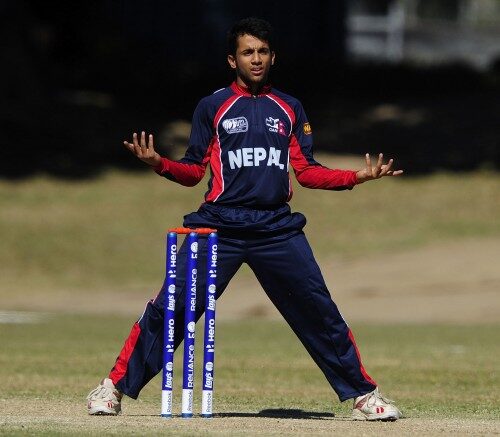Australia thrashed Nepal by 212 runs. Ireland beat Nepal by 14 runs. England outplayed Nepal by 200 runs. Sri Lanka defeated Nepal by 8 wickets. These were results of first four matches of the ICC U19 Cricket World Cup in Australia.
Anything odd? Yes, of course. This was first time Nepal lost four straight matches in six U19 CWCs. In 2000, it had lost three matches straight but it was Nepal’s debut and the Super League – the second round of top 8 teams – where Nepal lost matches to India, Sri Lanka and England.
Nepal could end up the event on a positive note with a victory over Papua New Guinea on August 23 in the 13th-place playoff after registering the first win against Namibia. But regardless of those results, the performance of the team is unsatisfactory – and the most concerning factor is that Nepal looked nowhere near to the teams of the past.

Prithu Baskota of Nepal gestures during the ICC U19 Cricket World Cup 2012 match between Nepal and Ireland at Endeavour Park on August 15, 2012 in Townsville, Australia. (Photo by Ian Hitchcock-ICC/Getty Images)
The dark horse or giant-killer was just an ordinary team lacking the fighting spirit and competence. It was a team that would confidently beat the fellow Associates and pose a challenge to Test nation – rather it was a team that would compete against Associate and surrender meekly to the big ones.
The batting looked ever weaker. Bowling toothless and fielding seemed to be below average.
Why? There is an answer that could console all of us (probably the answer that Cricket Association of Nepal, the manager and the coach will give). Australia was a new for players, all of whom but one were debutants for Youth ODIs. The pitch and the environment of Australia were different and Nepali players failed to adapt to that.
However, I won’t be satisfied with that answer. Wasn’t New Zealand, when Nepal reached plate final in 2002, new for all players? And, why the team’s individual performance looked below average – the batting, the bowling and the fielding?
Who to blame? I wouldn’t blame the players. At this level, players tend to follow what managers and coaches ask them to do. That’s why former coach Roy Dias was always happy with age-group teams and had complaints against senior team.
I would not blame the players for they are nothing but raw talents. Whatsoever they did to qualify for the event is laudable.
I blame the CAN. I blame the coach. Both for not having a plan.
Luck is always not on our side. Many of the performances in U19 CWC were luck meeting opportunities. This time, there was no luck – partly because the players‘ talents were not matched by practices and plans.
I would not ask how much preparation there was for the team. I would not ask how long they played as a team before moving to Australia. I would not ask what vision and plan CAN had for them since they qualified for U19 CWC other than ‘mandatory closed-camp trainings’ and ‘a week time in Australia’.
I certainly want to ask did the team have any plan? Did coach Pubudu Dassanayake have any plan for matches? He looked to be testing players all the time – rotating openers and bowlers. It was a trial and errors many times. Why would you play someone who would bat at #11 and wouldn’t bowl until 49th over (ref. Saurav Khanal). For me, he looked in complete disarray still trying to find out who is who in the team rather than utilizing the best available options.
I feel sad to say but I was hugely disappointed with the coach despite all the praises I had for him during the senior team’s Twenty20 events. However, I do hope that CAN, coach and players would learn some lessons from the event and draw positive conclusions to improve the team and future matches.
The upcoming World Cricket League Division IV will be a big test!
